
What Women in Pop Culture Teach Us About the Many Joys of Anger
Some women have good reason to be angry, and others don’t. But that doesn’t matter.

With hair in a messy bun, arms crossed, and a fury that screams “Eat Me,” Kat Stratford is very angry. In 10 Things I Hate About You (1999), Kat embodied the rage of a young woman against a misogynistic and divided society. Kat was the subversive “shrew” no one could tame. Over a decade later comes Selina Meyer, the capricious vice president in Veep. She struts around in heels around the White House, forever on the edge of irritation and a blowout, as she tries to break the glass ceiling in the world of politics laden with misogyny. Her anger is unlike Alana Kane’s in Licorice Pizza (2021), the twentysomething runs breathless with indignation in the movie; one so much so as breaths in her space and her groan would be piercing. The world and its ideals – Alana herself – are all out of order.
The existence of these angry women on our screens and pages is extraordinary. These women are anti-heroes, defying societal expectations that audaciously demand serenity, care, and joy from women.
These arresting representations of feminine anger stop the camera on moments of acrimony. In doing so, they reframe anger as a manifestation of grief over injustice, both personal and structural. Angry women are grieving women. Even imperfect women — whose rage is righteous only sometimes — are warranted a legitimacy that has historically been denied. Such representations of anger in the media become a way for women to reclaim space and assertively make room within it for collective healing.
***
Women have long been socialized into being invisible – our presence, our laughs, our voices, our mistakes must be tucked away neatly in a box. This also distances us from our anger. “We are trained that our reactions should also be silent, be it of laughter, wonder, amazement, anger, or grief,” says Rashi Bhargava, an assistant professor of sociology. Angry women are unseemly women. Unladylike, unbecoming.
In her article “Does Your Daughter Know It’s OK To Be Angry?,” writer and activist Soraya Chemaly explains just how easily women lose awareness of their own anger. “Anger is diverted in women… Girls are taught, through politeness norms that suppress disruptive behavior, to use indirect methods of dealing with rage….” Women are expected to resolve their anger by themselves, their hurt ignored like a red light that will stop blinking on its own. Chemaly added: “Adaptable girls find socially acceptable ways to internalize or channel their discomfort and ire, sometimes at great personal cost.”
The prototype woman is meek and mild. “Any woman who digresses from the preconceived notions of ‘femininity’ is either seen as crazy, mad, or manly that will only bring about destruction or chaos that will lead to ‘sarvanaash’ (‘destruction’),” notes Rashi. In Indian mythology, both Shiva and Durga are angry divine figures. But while Shiva’s Rudra Roop is seen as being “regenerative,” Durga’s Kali Roop leads to destruction. Men’s anger has thus always been seen as productive and justified, and women’s as unwarranted.
The problem is simple but scathing: If the mantle of anger and rage is reserved only for one gender, the others never get any agency. When docility and silence are valued, women become anecdotes, symbols, portraits of perfection belonging to everyone but themselves.
Related on The Swaddle:
All The Arguments You Need: To Convince Doubters of Feminism
In denying marginalized sections the freedom to express anger or grief more visibly, society ensures they remain within their assigned roles. “Men fear our chaotic rage, but not nearly as much as they fear our focused grievances about very real injustice,” wrote author Jess Zimmerman. “There is little more threatening to the social order than a woman who’s angry. The only thing scarier is a woman who’s angry about something.”
So, within activism, the “angry feminist” label is used as a taunt to discredit those who care. It not only delegitimizes women’s concerns and their emotions but also their political subjectivity as a collective, explains Rashi. Women must be extolled for their miseries but shunned for their resentment.
There is abundant research detailing what suppressed rage does to any person: it results in anxiety, depression, and cases of displaced aggression that affect everyone around. When women do end up expressing their anger, they often feel guilty for feeling an emotion so unnatural and so “deviant” in the first place. S*, 47, a mother of two, frequently notes the unease that comes after she loses her temper – she was supposed to be calm and composed, wasn’t she? Anger defies logic, but if there were one, it is that people are only ever angry about something they care about. If others discount that anger, they also discount the subjects of our individual care. Women’s relationship with anger is fractured, even absent, as the invalidation becomes a cultural reality. In doing so, notes Rashi, “we have built a certain subjectivity that is not easily transformable.”
There is little room in today’s world for women to be angry. This is what makes the portrayal of angry women important and extraordinary – it helps women realize their anger matters. It “connect[s] them to an entire universe of women no longer interested in making nice at all costs,” as Chemaly writes in Rage Becomes Her.
And that is exactly what Mildred Hayes does in Three Billboards Outside Ebbing, Missouri (2017). Mildred is a caustic, grieving woman on a rage-filled crusade to find justice for the rape and murder of her teenage daughter. She describes herself as a “cunt,” attacks a taunting dentist with a drill, and throws Molotov cocktails into the police station. Despite undergoing the worst tragedy conceivable for a mother, she receives little sympathy from the people of fictional Ebbing, simply because her rage stands in contrast to the ideal picture of a grieving woman.
Mildred’s story shows how easy it is to misunderstand a woman’s pain and cast her anger as an “emotional fit” or an “inconvenience” that defies norms. How dare a grieving mother let anger dominate her senses?
As feminist author Gloria Steinem famously said, “The angry woman — she definitely has something to be angry at.” The root of anger is pain caused by a world order that is incredibly chaotic and broken. A perfectly heartbreaking example of this is playing out before our eyes with the recent overturning of Roe v. Wade, whichaugursa world where abortion rights stand at the precipice of death. The collective anguish and rage felt by women around the world are as much about demanding reproductive justice as it is about responding to centuries of systemic exploitation and dehumanization. Women have waited for far too long, only to reach a point where they have fewer rights than before. In this moment of absurdity, our rage can keep us centered and sane enough to continue fighting.
Related on The Swaddle:
How the Pandemic Generation Became Disillusioned With the Coming‑of‑Age Genre
Letting anger dominate our cultural sensibilities is thus a subversive act. If “grief weakens the knees and blinds the eyes,” as author Joan Didion put it, anger is perhaps the only compass to navigate a distorted social reality.
There is something cathartic about watching Jobu Tupaki, an interdimensional “evil,” in Everything Everywhere All at Once (2022) tear through the universes, devouring her grief visibly. Her unleashed rage at a galaxy in disarray is also a scream of pain. In linking anger as an emotion to be felt and not disregarded, these representations legitimize grief and anger. Instead of discounting rage, we begin to spot it and even value it for its unwavering persistence. Anger becomes an appropriate response to things that demand anger. It returns credibility to issues that are normalized, sidestepped, and even forgotten.
In Kevin Can F*** Himself (2021), we see Allison, the satirical sitcom wife, become truly and utterly tired of her husband, of feeding him, taking care of him, passing him beers, and then going back into the kitchen to be the “good wife.” Allison snaps like elastic every day, smashing glasses in rage. By the end, her anger reaches a crescendo. In a dramatization that plays out in her mind, she sees herself shattering a beer mug and plunging a sharp edge into Kevin’s throat. But our empathy still lies with Allison and the female rage she represents. Her rage is not only against Kevin, but the sexism of sitcom shows that prompt laughs at the expense of women who are demeaned and derided.
Talking about Amrita, Tapsee Pannu’s character in Thappad (2020), Rashi says, “Her anger is not exaggerated and is definitely not violent – it just seems so relatable. If such portrayals are clubbed together as ‘angry,’ then so be it as long as they represent women as thinking, acting, rational and emotional subjects.” Amrita asks for divorce after her husband slaps her at a party, which rudely awakened her to the realities of her marriage and gender. Although most people do not see “reason” behind her anger, she stands her ground, thereby liberating other women trapped behind bars of domestic servility.
When we stop sanitizing women’s narratives, we send a potent message: that their stories are legitimate and worthy of existing as is. That women can live and breathe and feel – all without their attitudes and behavior being subjected to the utmost moral scrutiny.
In Good and Mad: The Revolutionary Power of Women’s Anger, Rebecca Traister talks about how female rage can truly transform our world. That anger is an unappreciated feminist political tool that is not only important for political change but also for healing. Rage can also inspire solidarity, even if imperfect.
Three Billboards shows Mildred’s anger as a necessity, the only way to affect action in a rigid world full of rigid ideas. Her anger re-imagines justice and approaches it with an exhausted but empowering grief.
Anger is wonderfully fascinating and complicated to think about. Then, the stories of women like Amrita, Mildred, and Allison create charged spaces for real-life women who are complicated too — women who make mistakes, women who dare to visibilize their grief, and women who are people, not caricatures bound to the ropes of submissiveness.
Saumya Kalia is an Associate Editor at The Swaddle. Her journalism and writing explore issues of social justice, digital sub-cultures, media ecosystem, literature, and memory as they cut across socio-cultural periods. You can reach her at @Saumya_Kalia.
Related


It’s Okay: To Choose a Short‑Term Relationship Over a Stable One
